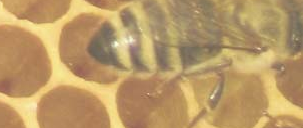
Honeybees predate humans by 10 to 20 million years and are one of the oldest forms of animal life still in existence. Here is a concise history of the use of honey by humans and beekeeping.
- 50,000 BC - It is highly likely that early hominids were at least as capable of honey collection, and like modern apes, australopithecines may have used sticks to retrieve honey.
- Neolithic Age (7000 - 8000 BC) - Primeval humans gathered and ate the honey and honeycombs of wild bees as long ago as 8000 B.C A cave painting in Valencia, Spain shows humans foraging for honey.
- Bronze Age - Pregistoric humans made mead, a honey-based alcoholic (fermented) beverage. The use of beeswax most likely dates to this era as well, as it is prominent in ancient folklore and mythology., being used in the rites of birth, circumcision, marriage, purification, and death; embalming, sealing coffins, and mummification as well as candles.
- 3000 - 4000 B.C., Mankind starts keeping bees.
- 2700 BC - Honey, beeswax, and propolis have been used extensively in medicine as drugs for treating wounds.
- 2600 and 2200 B.C. - Honey was the most popular ancient Egyptian drug . Almost all Egyptian medicines contained honey together with wine and milk. The ancient Egyptians offered honey to their deities as a sacrifice (36). They also used honey for embalming the dead. Honey was utilized for its antibacterial properties that helped heal infected wounds when used as a topical ointment.
- 2000 - 1000 BC - Ancient Greeks drank a beverage called Oenomel made from honey and unfermented grape juice. It was also used as a folk remedy for gout and certain nervous disorders . Hippocrates prescribed a simple diet, favouring honey given as oxymel (vinegar and honey) for pain, hydromel (water and honey) for thirst, and a mixture of honey, water and various medicinal substances for acute fevers. Also he utilized honey for baldness, contraception, wound healing, laxative action, cough and sore throat, eye diseases, topical antisepsis, prevention and treatment of scars.
- 600 - 1000 AD - Islamic medicine considered honey to be a healthy drink. The holy Qur'an describes the potential therapeutic value of honey: "And thy Lord taught the bee to build its cells in hills, on trees, and in (men’s) habitations; Then to eat of all the produce (of the earth), and find with skill the spacious paths of its Lord: there issues from within their bodies a drink of varying colors, wherein is healing for men: verily in this is a sign for those who give thought".
- In medieval times, beeswax was also used as a currency, exacted as tribute from conquered nations and was used in writing, painting, sculpturing, and protecting works of art, as well as for illumination.
- 1622 AD - The honey bee (Apis mellifera L.) as we know it today, is not native to the Western Hemisphere. Native Americans did collect wax and honey from native stingless bees (Meliponids and Trigonids) in the West Indies, Central and South America, but the European honeybee is far more productive. Pilgrims brought the first honey bees to North America in the 1600s.
- 1850's - European honeybees had spread across the continent by the 1850s.Settlers used set box traps to trap worker bees and then release them to follow the bees back to their hive.
- 1852, L. L. Langstroth, a Congregational minister from Pennsylvania, invented and patented a hive with movable frames that is still used today. This caused honey production to soar.
References
- History of Beekeeping in America,m Beesource.com, EVERETT OERTEL, Retired, formerly apiculturist, U.S. Department of Agriculture.
- USDA
- Iranian Journal of Nasic Medical Sciiences
- Smithsonian Magazine